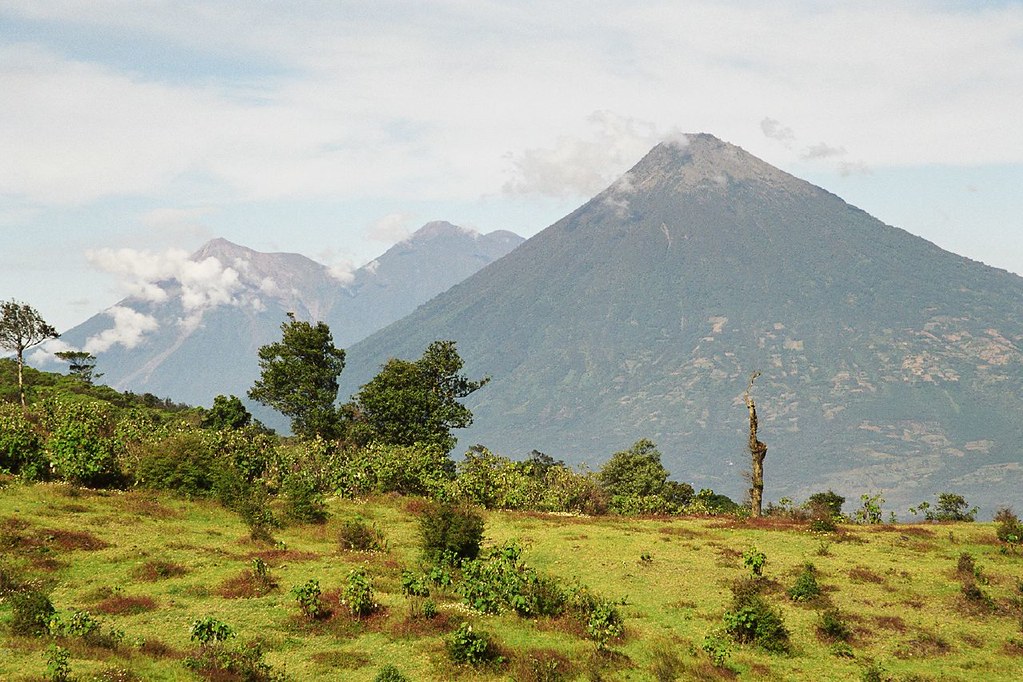You’re standing at the base of a towering giant, the Acatenango volcano, with its peak shrouded in the mists of Guatemala’s highlands. The air is crisp, the sky a clear blue, and your heart is pounding with anticipation. This isn’t just any hike; it’s a journey to one of the most awe-inspiring natural spectacles on Earth. As a solo hiker, you’re about to embark on an adventure that will test your limits and reward you with sights that few have witnessed.
This is the story of my solo hike up Acatenango, and it’s one I’ve been dreaming of for years. The thought of watching Volcan de Fuego erupt, spewing rocks, smoke, and lava into the sky, has been a constant source of excitement and trepidation. But as I discovered, the reality far surpasses anything the internet could conjure.
Acatenango stands majestically at 13,045 feet, a mere hour’s drive from the charming city of Antigua. With numerous trails leading to its summit, the most popular spans 8.5 miles round trip, demanding a staggering 5,269 feet of elevation gain. For those considering this climb, here’s a comprehensive guide to tackling Acatenango solo, based on my unforgettable experience.
Climbing Acatenango on your own is an exhilarating prospect
Contrary to popular belief, a guide isn’t mandatory to witness the Fuego eruption or reach the summit. While guided tours are prevalent, they’re not the only way to conquer this behemoth. The climb can be completed in a day or stretched to an overnight excursion. During my ascent, I encountered numerous solo hikers, each carrying their gear, their determination etched on their faces. The primary advantage of a guided group is the assistance of porters, who alleviate the burden of carrying equipment up the steep incline. If you’re considering an overnight stay without the weight, a guided trip might be your best bet. However, for day-trippers like myself, a tour is entirely optional.
The journey to the trailhead is the most logistical challenge when climbing Acatenango solo. My own trek began with a race against time, as my return flight to the states was scheduled for the early hours following the hike. The trailhead, located on the outskirts of a small town on a remote mountain road, isn’t the easiest to access, especially post-sunset. But fear not, for there are a couple of ways to reach it from Antigua:
Option one is to hail an Uber or Taxi, which is precisely what I did. The ride from Antigua to the trailhead took about an hour and cost 230 GTQ (around $29 USD). To ensure a smooth return, I negotiated with the driver to pick us up after the hike and even arranged a trip to the airport. The total fare for this convenience was a generous 1000 GTQ. Alternatively, you could hire a private driver in advance, though this is the pricier option, potentially costing around $200 for the day. While this does alleviate stress, it’s worth noting that it’s more expensive than most overnight guided tours.
Once at the trailhead, the real adventure begins. There’s only one path to the summit, starting at the coordinates 14.536804, -90.883548. The initial stretch is a gravel road leading to ‘Plaza I Love Acatenango,’ the official starting point, complete with amenities. From there, the trail snakes through farms and woods on a steep, dirt path with makeshift stairs. After the first 1,000 feet of elevation, you’ll encounter an entrance gate where a 10 GTQ fee is required.
The trail splits, allowing you to pick your path
The Red Path is favored by guided tours, circling around the mountain to camps on the Fuego side before curving to the summit. If you’re aiming for the Fuego saddle, this is your route. Completing the entire loop, including the summit and Fuego saddle, tallies up to 12,263 feet of elevation gain over 15.7 miles.
The Blue Path offers a more direct ascent to the summit and is popular among those attempting a single-day climb. It spans 7 miles round trip with 5,200 feet of elevation gain. While it does have camping spots around 12,000 feet, it doesn’t afford views of Volcan de Fuego until the summit. This was my chosen route.

For navigation, I recommend downloading GPS tracks on the Peakbagger app, as All Trails doesn’t feature both options.
Climbing Acatenango solo comes with its pros and cons. On the plus side, you have the freedom to choose when to summit. Guided groups typically camp overnight and ascend for sunrise, resulting in a crowded peak. By aiming for sunset, I shared the summit with only a handful of hikers, enjoying a serene and unobstructed view.
However, the price and logistics can be a downside. Guided treks are reasonably priced, around $115 for an overnight tour, making them an attractive option for many. Yet, going solo allows for flexibility in route selection, as mentioned earlier.
The absence of porters is another consideration. The best basecamps are situated between 12,000 and 12,500 feet, so if you’re camping solo, be prepared for a hefty carry.
On the flip side, there’s no rush when you’re on your own. I lingered on the summit for an hour, mesmerized by the sunset and the subsequent lava eruptions. Guided trips, constrained by time, may miss out if the volcano isn’t active during their stay.
One notable disadvantage is the lack of nighttime views of Fuego. Most guided camps are positioned within sight of the volcano, allowing for an evening spectacle of flowing lava. The direct route obscures Fuego until the summit, so you won’t witness any nocturnal lava displays.
Yet, the ability to trek at your own pace is a significant advantage. Guided groups move slower, taking most of the day to reach camp. I managed to summit and return to the trailhead in just 5.5 hours. Conversely, if you’re a slower hiker, the guided pace may suit you better.
For my solo climb, I packed light and fast. Using the app Stasher, I stored my bags at a hotel in Antigua for $5 per bag. My essentials included 3.5 liters of water, energy chews, a down jacket, gloves, a thermal layer, additional snacks, entrance money, a headlamp, a hat, sunglasses, sunscreen, and ibuprofen. In hindsight, an extra layer would have been welcome, as the post-sunset winds left me shivering at the summit.
This guide is a culmination of my experiences and the joy of conquering Acatenango solo. The sunset I witnessed from the peak was the best of my life, and I hope this account inspires you to embark on your own adventure. Enjoy the climb, and may your journey be as fulfilling as mine!
Navigating Acatenango’s Trails: Insights and Experiences
The ascent of Acatenango is a tale of two worlds: the earthly struggle of the climb and the celestial reward at the summit. As I embarked on the trail, the path ahead was a mosaic of natural beauty and physical challenge. The trail’s ruggedness is a testament to the untamed spirit of the Guatemalan highlands, and every step taken is a step closer to the heavens.
The initial ascent through the farmlands is a gentle introduction to the journey. The soft chatter of local farmers and the rustle of the wind through the cornstalks provide a soothing soundtrack. But as the elevation increases, the terrain shifts dramatically. The woods envelop you, and the path steepens, transforming into a relentless uphill battle. The makeshift stairs carved into the dirt are a reminder of the countless feet that have trodden this path before, each seeking the summit’s promise.
As I climbed higher, the air thinned, and the vegetation changed. The trees became sparser, and the landscape opened up to reveal panoramic views of the surrounding mountains. The sight is a balm for the weary traveler, offering a moment of respite and a surge of motivation. The trail’s solitude is profound, with only the sound of my own breath and the occasional bird call piercing the silence.
Reaching the basecamps scattered along the trail is a milestone in itself. Each camp offers a glimpse into the camaraderie and spirit of those who choose to spend the night. The tents huddle together, forming temporary communities bound by a shared goal. For a moment, I envied the overnight hikers, who would witness the nocturnal spectacle of Fuego’s eruptions. Yet, my own mission was to reach the summit and return before nightfall.

The final push to the summit is a grueling test of endurance. The loose volcanic ash underfoot makes each step feel like a battle against the mountain itself. But the promise of the view ahead propels me forward. As I neared the peak, the anticipation grew. The thought of standing atop Acatenango, face to face with the raw power of Volcan de Fuego, was exhilarating.
And then, there it was: the summit. The world below seemed distant, a tapestry of greens and browns stitched together by the hands of nature. The sight of Volcan de Fuego, with its plumes of smoke and occasional bursts of lava, was mesmerizing. It was a performance of elemental forces, a reminder of the Earth’s potent energy. The sunset cast a golden glow over the landscape, and as the sky darkened, the lava’s glow intensified, painting the night with streaks of red and orange.
The descent was a reflection on the day’s journey. With each step down, I replayed the climb in my mind, savoring the triumphs and the challenges. The mountain had tested me, but it had also rewarded me with memories that would last a lifetime. As I reached the trailhead, the stars began to emerge, a celestial salute to the day’s adventure.
The solo hike up Acatenango is an experience that defies words. It’s a journey of self-discovery, a physical and mental challenge, and an encounter with the sublime beauty of nature. For those who dare to take on the mountain alone, the rewards are immeasurable. The sense of accomplishment, the connection to the Earth, and the awe-inspiring views are the treasures that await at the summit. Acatenango is not just a volcano; it’s a portal to a world of wonder, and I am grateful to have passed through it.
Related posts:
Climbing Acatenango On Your Own: Everything You Need to Know
Acatenango Volcano Hike Difficulty: BEST GUIDE [2024]
Acatenango Volcano Hike || Complete guide & review of Soy Tours





